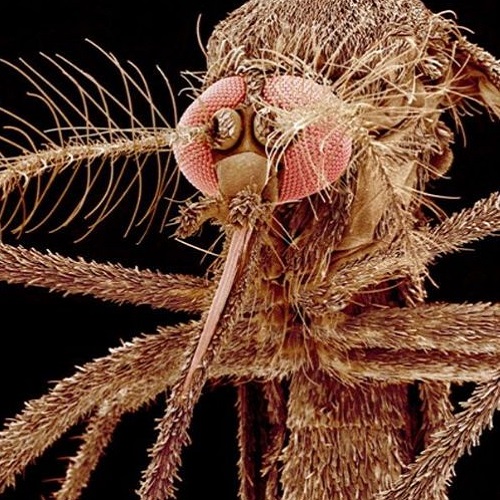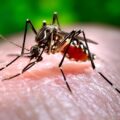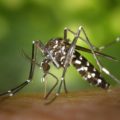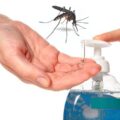According to the World Health Organization, mosquitoes are the most dangerous creature on earth. Mosquitoes and the diseases they spread have been responsible for killing more people than all the wars in history. Even today, mosquitoes transmitting malaria kill 2 million to 3 million people and infect another 200 million or more every year. Tens of millions more are killed and debilitated by a host of other mosquito-borne diseases,
List Of Diseases Spread By Mosquitoes
1. Malaria
Malaria is an ancient disease. In all likelihood originating in Africa, it has been described by the Chinese as far back as 2700BC and the Sumerians from 1700 BC. The malaria parasite (plasmodium) is transmitted by female Anopheles mosquitoes. The term malaria is attributed to Horace Walpole in a letter from Italy in 1740 and is derived from the Italian ‘mal-aria” or “bad air” because it was thought to come from the wind from swamps and rivers. Scientists conducted much research on the disease during the 1880s and early 1900s. Approximately 40% of the world’s population is susceptible to malaria, mostly in the tropical and sub-tropical areas of the world. It was by and large eradicated in the temperate area of the world during the 20th century with the advent of DDT and other organochlorine and organophosphate mosquito control insecticides. An elevated standard of living, including the use of air conditioners and window screens, along with public health interventions have largely remanded malaria transmission to tropical areas. Nonetheless, it can still be found in northern Europe. SEE: Does Hand Sanitizer Repel MosquitoesV
More than one million deaths and 300 – 500 million cases are still reported annually in the world. It is reported that malaria kills one child every 40 seconds. In the United States, malaria affected colonization along the eastern shore and wasn’t effectively controlled until the 1940s when mosquito control organizations instituted Anopheles control programs. A resurgence occurred during the 1960s and early 70s in the United States due to returning military personnel from Vietnam. Minor outbreaks of locally-acquired malaria occur sporadically in the United States but have been quickly controlled by aggressive mosquito control measures. The influx of illegal immigrants in addition to returning tourists may provide for infrequent outbreaks in the future. Anopheles quadrimaculatus and Anopheles freeborn have been the primary vector of the Plasmodium vivax (protozoa) in the United States (Foote and Cook 1959).
Antimalarial drugs have been available for more than 50 years and recently scientists in Britain and the United States have cracked the code of the malaria parasite genome, a step that may help boost the campaign against the disease. In the meantime, active case detection
2. Chikungunya
Chikungunya virus is a pathogen transmitted by mosquitoes and has established itself in the Caribbean (approximately 350,000 suspected cases in the Western Hemisphere since December 2013). It has now resulted in 2 cases of locally-transmitted Chikungunya virus in Florida in July of 2014. As of July 22, 2014, 497 travel-related cases have been found in 35 states, Puerto Rico, and the U.S. Virgin Islands. The occurrence of locally-transmitted cases causes public health officials to fear its spread and establishment in states bordering the Caribbean. The name “Chikungunya” is attributed to the Kimakonde (a Mozambique dialect) word meaning “that which bends up”, which describes the primary symptom – excruciating joint pain. Although rarely fatal, the symptoms are debilitating and may persist for several weeks. There is no vaccine and primary treatment is limited to pain medication.
The type of mosquito species that transmit this disease is the Asian Tiger Mosquito (Aedes albopictus) and the Yellow Fever Mosquito (Aedes aegypti). Genetically, it appears that the viral strain currently spreading throughout the Americas is more easily transmitted by Ae. aegypti. Both species lay their eggs in containers such as cans, discarded tires, and other items that hold water close to human habitation, but Ae. aegypti is more geographically confined to the southeastern United States. Traditional mosquito methods of truck-mounted and aerial sprays are ineffective in controlling these mosquitoes. Removal of water-bearing containers and sanitation are key preventive strategies.
3. Dog Heartworm (Dirofilaria Immitis)
Dog heartworm (Dirofilaria immitis) can be a life-threatening disease for canines. The disease is caused by a roundworm. Dogs and sometimes other animals such as cats, foxes, and raccoons are infected with the worm through the bite of a mosquito carrying the larvae of the worm.
It is dependent on both the mammal and the mosquito to fulfill its life cycle. The young worms (called microfilaria) circulate in the blood stream of the dog. These worms must infect a mosquito in order to complete their lifecycle. Mosquitoes become infected when they blood to feed on the sick dog. Once inside the mosquito, the microfilaria leaves the gut of the mosquito and live in the body of the insect, where they develop for 2-3 weeks. After transforming twice in one mosquito the third stage infective larvae move to the mosquito’s mouthparts, where they will be able to infect an animal. When the mosquito blood feeds, the infective larvae are deposited on the surface of the victim’s skin. The larvae enter the skin through the wound caused by the mosquito bite. The worms burrow into the skin where they remain for 3-4 months. If the worms have infected an unsuitable host such as a human, the worms usually die. The disease in dogs and cats cannot be eliminated but it can be controlled or prevented with pills and/or injections. Some risk is present when treating dogs infected with heartworms but death is rare; still, prevention is best. Of course, good residual mosquito control practices reduce the threat of mosquito transmission. Until the late sixties, the disease was restricted to southern and eastern coastal regions of the United States. Now, however, cases have been reported in all 50 states and in several provinces of Canada.
Arthropod-borne viruses (arboviruses) are the most diverse, numerous, and serious diseases transmitted to susceptible vertebrate hosts by mosquitoes and other blood-feeding arthropods. Arboviral encephalitides are primarily zoonotic, being maintained in complex life cycles involving a nonhuman primary vertebrate host and a primary arthropod vector. These cycles usually remain undetected until humans encroach on a natural focus, or the virus escapes this focus via a secondary vector or vertebrate host as the result of some ecologic change. Humans and domestic animals can develop clinical illness but usually are “dead-end” hosts because they do not produce significant viremia, and do not contribute to the transmission cycle. There are several virus agents of encephalitis in the United States: West Nile virus (WN), eastern equine encephalitis (EEE), western equine encephalitis (WEE), St. Louis encephalitis (SLE), La Crosse (LAC) encephalitis, dengue, and yellow fever all of which are transmitted by mosquitoes. Another virus, Powassan, is a minor cause of encephalitis in the northern United States and is transmitted by ticks. A new Powassan-like virus has recently been isolated from deer ticks. Encephalitis is global, in Asia, for example, about 50,000 cases of Japanese encephalitis (JE) are reported annually.
4. Dengue
Dengue is a serious arboviral disease in the Americas, Asia, and Africa. Although it has low mortality, dengue has very uncomfortable symptoms and has become more serious, both in frequency and mortality, in recent years. Aedes aegypti and Ae. albopictus are the vectors of dengue. These mosquitoes prefer to lay their eggs in containers close to human habitations and are not well-controlled by standard spraying techniques. The spread of dengue throughout the world can be directly attributed to the proliferation and adaptation of these mosquitoes. Over the last 16 years dengue has become more common, for example; in south Texas 55 cases were reported in 1999 causing one death. More recently, Hawaii recorded 85 cases of dengue in 2001 and the Florida Keys reported over 20 cases in 2010. In 2004 Venezuela has reported more than 11,600 cases of classic dengue fever and over 700 cases of DHF. Indonesia dengue outbreak has caused over 600 deaths and more than 54,000 cases. In 1999, Laredo and Nuevo Laredo had an outbreak of almost 100 cases.
In 2010, Puerto Rico experienced its largest outbreak, with 21,000 cases reported. In 2009, Florida reported the first cases of local dengue transmission in 75 years, within Old Town, Key West. A serosurvey of residents suggested an infection rate of 5%, indicating a serious risk of transmission. Despite thorough control efforts carried out by the county and state in early 2010, by the end of 2010, Florida had reported an additional 65 locally acquired dengue cases. All the cases were in Key West, except two cases in two more northerly counties.
5. Yellow Fever
Yellow fever, which has a 400-year history, at present occurs only in tropical areas of Africa and the Americas. It has both an urban and jungle cycle. It is a rare illness for travelers anymore because most countries have regulations and requirements for yellow fever vaccination that must be met prior to entering most countries. Every year about 200,000 cases occur with 30,000 deaths in 33 countries. It does not occur in Asia. Over the past decade, it has become more prevalent. In 2002 one fatal yellow fever death occurred in the United States in an unvaccinated traveler returning from a fishing trip to the Amazon. In May 2003, 178 cases and 27 deaths caused by yellow fever were reported in southern Sudan. In the Americas 226 cases of jungle yellow fever have been reported with 99 deaths.
6. Eastern Equine Encephalitis (EE)
Eastern Equine Encephalitis (EEE) is spread to horses and humans by infected mosquitoes. It is among the most serious of a group of mosquito-borne arboviruses that can affect the central nervous system and cause severe complications and even death. EEE is found in freshwater hardwood swampland in the Atlantic and Gulf Coast states in the eastern part of North America, Central, and South America, and the Caribbean. It has a complex life cycle involving birds and a specific type of mosquitoes including several Culex species and Culiseta melanura. These mosquitoes feed on infected birds and become carriers of the disease and then feed on humans, horses, and other mammals. EEE cannot be transmitted from humans or other mammals because the viremia presented in the disease is not sufficient for further transmission. Thus, humans and other animals are known as “dead-end hosts.” Symptoms may range from none at all to a mild flu-like illness with fever, headache, and sore throat. More serious infections of the central nervous system lead to a sudden fever and severe headache followed quickly by seizures and coma. About half of these patients die from the disease. Of those who survive, many suffer permanent brain damage and require lifetime institutional care. There is no specific treatment. A vaccine is available for horses, but not humans.
7. St. Louis encephalitis (SLE)
St. Louis Encephalitis (SLE) is transmitted from birds to man and other mammals by infected mosquitoes (mainly some Culex species). SLE is found throughout the United States, but most often along the Gulf of Mexico, especially Florida. Major SLE epidemics occurred in Florida in 1959, 1961, 1962, 1977, and 1990. The elderly and very young are more susceptible than those between 20 and 50. During the period 1964-1998 [35 years] a total of 4478 confirmed cases of SLE were recorded in the United States Symptoms are similar to those seen in EEE and like EEE, there is no vaccine. Mississippi’s first case of St. Louis Encephalitis since 1994 was confirmed in June 2003. Previously the last outbreak of SLE in Mississippi was in 1975 with over 300 reported cases. It was the first confirmed mosquito-borne virus in the United States in 2003. It turned up in October 2003 in California Riverside County in sentinel chickens. The last [SLE] human case in California occurred in 1997. In Louisiana, in 2003 there was a fatal St Louis Encephalitis case previously listed as a West Nile caused death.
8. Lacrosse Encephalitis (LAC)
LaCrosse encephalitis (LAC) is much less widespread than EEE or SLE, but approximately 90 cases occur per year occurs in all 13 states east of the Mississippi, particularly in the Appalachian region. It was reported first in 1963 in LaCrosse, Wisconsin and the vector is thought to be a specific type of woodland mosquito (Aedes triseriatus) called the tree-hole mosquito, with small mammals the usual warm-blooded host. Infrequent fatalities occur in children younger than 16. It is not transmissible from human to human. There is no vaccine for LaCrosse encephalitis.
9. Western Equine Encephalitis (WEE)
Western Equine Encephalitis (WEE) was first recognized in 1930 in a horse in California. It is found west of the Mississippi including parts of Canada and Mexico. The primary vector is Culex tarsalisand birds are the most important vertebrate hosts with small mammals playing a minor role. Unlike LAC it is nonspecific in humans and since 1964 fewer than 1000 cases have been reported As with EEE a vaccine is available for horses against WEE but not for humans. In Arizona 3 counties have been found with sentinel chicken flocks seroconverting to WEE.
10. West Nile Virus (WNV)
West Nile virus (WNV) emerged from its origins in 1937 in Africa (Uganda) into Europe, the Middle East, west and central Asia, and associated islands. It is a Flavivirus (family Flaviviridae) with more than 70 identified viruses. Serologically, it is a Japanese encephalitis virus antigenic complex similar to St. Louis, Japanese and Murray Valley encephalitis viruses. Similar to other encephalitises, it is cycled between birds and mosquitoes and transmitted to mammals (including horses) and man by infected mosquitoes. WNV might be described as one of four illnesses: West Nile Fever might be the least severe and is characterized by fever, headache, tiredness, and aches or a rash. Sort of like the “flu”. This might last a few days or several weeks. At least 63% of patients report symptoms lasting over 30 days, with the median being 60 days. The other types are grouped as “neuroinvasive disease” which affects the nervous system; West Nile encephalitis which affects the brain and West Nile meningitis (meningoencephalitis) which is an inflammation of the brain and membrane around it. (CDC)
It first appeared in North America in 1999 in New York (Cornell Environmental Risk Analysis Program) with 62 confirmed cases and 7 human deaths. Nine horses died in New York in 1999. In 2001, 66 human cases (10 deaths) were reported in 10 states. It occurred in birds or horses in 27 states and Washington D.C., Canada and the Caribbean. There were 733 horse cases in 2001 with Florida reporting 66% of the cases; approximately 33% were fatal. In 2001 more than 1.4 million mosquitoes were tested for WNV. In the United States (2004) over 43 species of mosquitoes have tested positive for WNV transmission, the Culex pipiens group seems the most common species associated with infecting people and horses. Currently, 65 mosquito and 300 bird species have tested positive in the United States for this virus.
During 2002, the number of areas reporting WNV grew to 44 states and 5 Canadian provinces. The only states not reporting WNV were Alaska, Arizona, Hawaii, Nevada, Oregon, and Utah that year. Intrauterine transmission (CDC MMWR) and laboratory infections (CDC MMWR) were reported for the first time. In all, over 3800 human cases with 232 fatalities in 39 states and Washington DC were recorded. More than 24,350 horse cases of WNV were confirmed or reported in 2002. There is a vaccine for horses. Even alligators (CDC-EID) were found infected in Georgia.
The first confirmed 2003 WNV infection was in South Carolina on July 7th, 2003. South Dakota confirmed a WNV infection in a dog. The final CDC report list 9858 cases. As of 2014, there have been 36,437 cases of WNV reported to the CDC. Of these, 15,774 have resulted in meningitis/encephalitis and 1538 were fatal. CDC estimates that there have been at least 1.5 million infections (82% are asymptomatic) and over 350,000 cases of West Nile Fever, but the disease is grossly under reported due to its similarity to other viral infections.
11. Zika Virus
Zika virus has emerged from its origins in central Africa and has rapidly spread to the South Pacific and western hemisphere. A Flavivirus related to West Nile, Yellow Fever, St Louis, and the equine encephalitides, Zika was first discovered in macaque monkeys in 1947 in the Zika Forest region of Uganda. Since its discovery in 2014 off the coast of South America, Zika cases have been found in 35 countries in the Americas.
As of 28 April 2016, there have been 426 reported cases of Zika virus due to travel to endemic areas. However, local transmission within the continental United States has, as yet, not been reported. In US Territories in the Caribbean, a total of 599 cases have been reported, with 596 being locally acquired, primarily in Puerto Rico and the US Virgin Islands.
Although in rare cases Zika can be spread through sexual contact with an infected person, it is usually transmitted through the bit of an infected Aedes agypti or Aedes albopictus mosquito. The illness is usually quite mild, with fever, rash, conjunctivitis, and joint pain lasting a few days to several weeks or months. Often patients are not sick enough to seek medical treatment so a great many cases are not reported. It is thought that one attack confers immunity. However, cases of microcephaly, a congenital defect of the cranium and brain size resulting in profound neurological defects in newborns usually resulting in death have been positively identified as being caused by Zika infection. An autoimmune condition called Guillain-Barré syndrome, causing damage to nerve cells resulting in muscle weakness and, on occasion, paralysis and death have been linked to Zika infection.
The mosquito vectors of the Zika virus are peridomestic, preferring to lay their eggs above the waterline of containers, tree holes, creases in tarpaulins, and other vessels that may contain water. Aedes aegypti, in particular, will lay eggs in a series of containers after feeding. Both Aedes agypti and Aedes albopictus will feed day or night when a potential host comes within their limited flight ranges. Aedes agypti has more of a tendency to enter and stay within houses if conditions are proper. This species is exceedingly skittish, often leaving its host prior to taking a full blood meal when the host moves. Both mosquitoes also seem to prefer feeding on the host’s lower extremities.
Traditional outdoor ULV sprays are ineffective against Aedes agypti, it being difficult to obtain contact with the spray droplets in flight due to its cryptic habits. Some success with ULV sprays has been obtained against Aedes albopictus in urban areas, while suburban areas remain refractory. The primary means of controlling both species is to eliminate their oviposition habitats by removing water bearing containers or emptying them and scrubbing the insides to remove eggs deposited above the waterline. Personal protective measures such as the application of EPA-registered repellents and the wearing of long-sleeved shirts and long pants are also effective measures.
When traveling to areas endemic to Zika in the Caribbean, it is also recommended to stay in hotels with air conditioning and window and door screens to keep mosquitoes outside. If available, it is advised to sleep under mosquito bed nets.






